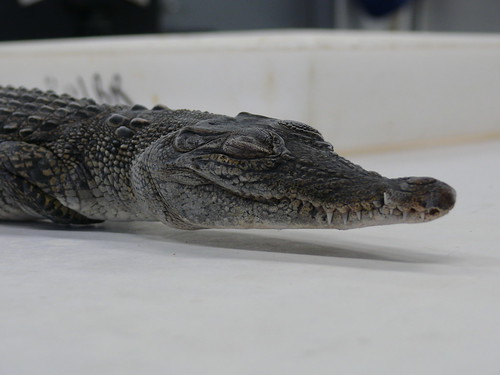
Is it even dead?!
Was saying to YC the other day that we had a chance to see a baby crocodile undergoing preservation by Mr Yeo, one of our museum curators, and the first thing he said was: gross!
Kind of, in my opinion. Especially at the part where blood and waste was spurting out of its mouth and genital opening. And the smell of rotting fish, combined with the sickly sweet smell of formalin... But you'll get used to it, I did so, anyway. Cheers to my blocked nose :p But all in all, it was quite fun and very fascinating.
(Ed: A short snippet on stuff I missed out:
The crocodile was from Sungei Buloh Wetlands Reserve. It was discovered "drowned in a drift net left behind by poachers who frequently enter the reserve from Kranji." (quoted from comment by Siva, see below) SBWR plans on using the crocodile as a display specimen for education, hence SBWR staff Jeremy Ang brought it to the Raffles Museum of Biodiversity for preservation on 23rd Feb 2007. Erm.. I do not know the reason why the preservation is only done now, but well.. the museum is very active, and there are many ongoing events, so.. yea..)
Let me outline the basic procedures here:
1) The crocodile was taken out of its newspaper wrapping and allowed to thaw under running water for around 45min. That's important for the step where Mr Yeo had to inject formalin into the body. If the body is hard the formalin won't go in.
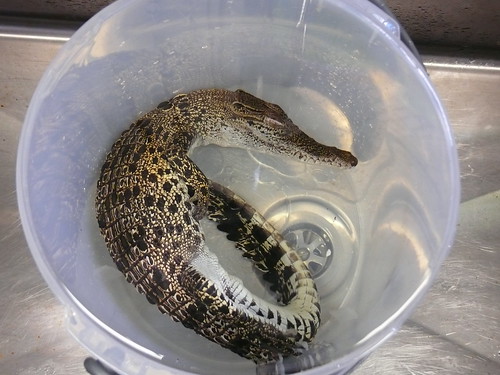
Curled innocently after being thawed in a tub.
2) 15% formalin was prepared from the standard stock of formaldehyde using a big measuring cylinder. Formalin is basically formaldehyde diluted with water. Usually 10% is sufficient but Mr Yeo uses 15% just to be on the safe side. Formalin is used to preserve the tissues to prevent decomposition, but it also hardens the tissue, so the concentration mustn't be too high as the tissue will become brittle and break off easily.

Measurement of pure formaldehyde to prepare the 15% formalin.
3) The height and weight of the crocodile was taken using a long ruler and a weighing scale respectively. The total length (snout to end of tail) is 75.2cm, body length (snout to beginning of tail) is 37cm and the weight is 942g. These information are recorded down on a label, together with the species name and where it was found.
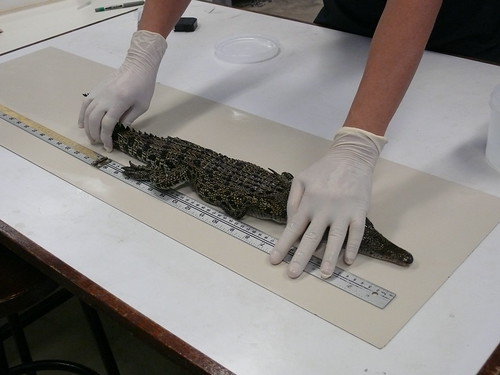
Taking the vitals of the croc.

Intent upon weighing it, here's a photo of Mr. Yeo in concentration.

Taking the vitals of the croc.

Intent upon weighing it, here's a photo of Mr. Yeo in concentration.
4) A plastic syringe was used to inject formalin throughout the length of the body. Mr Yeo prefers to start from small parts such as the tail and limbs before moving on to the head and stomach. He injects at half to one inch intervals. Usually he will cut open the body to pour formalin in, as plain injection does not usually get enough formalin into the body cavities which can result in partial rotting, but it is not possible in this case. (Sungei Buloh Wetlands Reserve wants the croc back whole) Therefore, he massaged the entire length of the croc to ensure that there is formalin throughout. He also poured formalin through the mouth down the throat.
5) Because formalin hardens the tissue, Mr Yeo put the croc on a styrofoam board, arranged it into a natural-looking position with head propped up using styrofoam and limbs fixed on the ground using pins to maintain a climbing stance. Then he put the entire thing into a box and submerged the croc with 15% formalin. To prevent the structure from floating, he weighed down the styrofoam board with bricks.
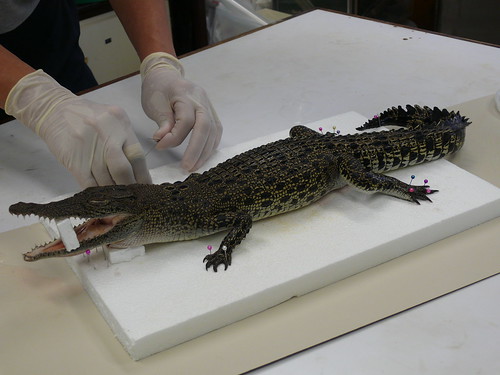
Mr. Yeo pinning little croc down with precise posturing!

All ready to be submerged in tub of formalin!
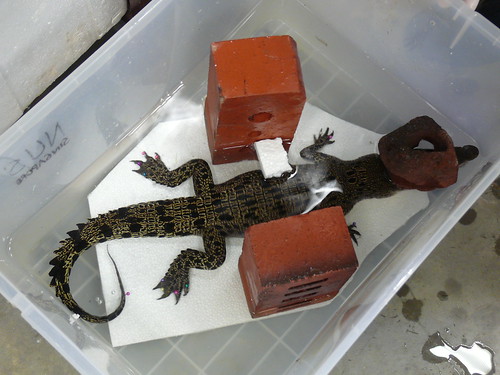
Nailed down by bricks.
Work done! ^^
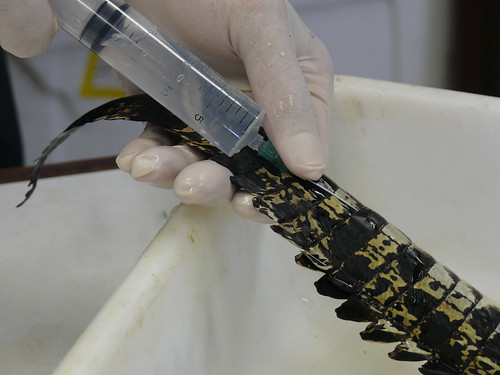

7 comments:
The memory stick lies on my table, sadly forgotten - ask Ruo Yu!
So, where was the croc from?
Waiting for Flickr to recover before uploading all the photos.
Forgot to mention that the croc was from Sungei Buloh!
Mr. Yeo wasn't very sure if it was caught, but speculated it was found dead.
He wanted to cut it open but SBWR wanted it intact and whole for display purposes.
Thanks for sharing this. It's a part of science that I don't think I'll ever get to see. :)
You're welcome! Hope it'll interest others like it did to you! =)
Jeremy Ang (SBWR) dropped it off at the museum on 23 Feb 2007. They had discovered the baby crocodile drowned in a drift net left behind by poachers who frequently enter the reserve from Kranji.
Sungei Buloh will use it as a display specimen for education. There have been crocs in the area for some years, see: http://tinyurl.com/2ecnmb
and http://tinyurl.com/3c3466
I'll put up a compilation of some records and photos later.
ivan: you're welcome ^^ i'm not around now, but i think ruoyu will put up more posts like this, so do hang around! :)
Post a Comment